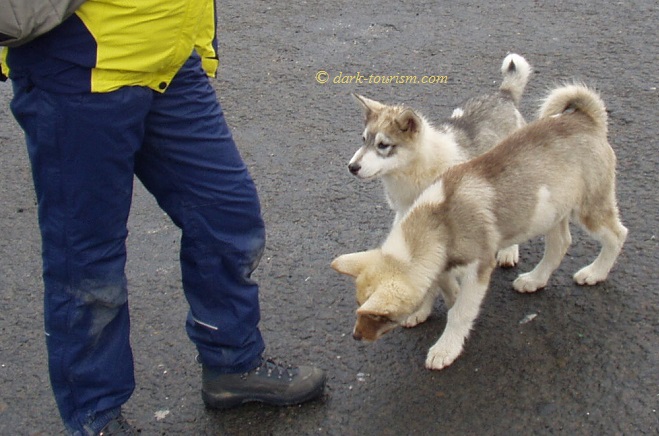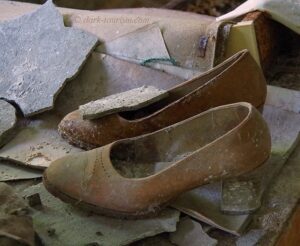In today’s post I’m not only offering you another respite from the mid-summer heat in terms of virtual travel, but I’m also featuring a country that doesn’t even have an entry (yet) on my main website: Greenland. There is one photo from there to be found on the website, and those readers very familiar with the site may have seen it. It’s in the ‘about’ section and functions like a kind of profile photo. It was also used for a similar purpose by the publishers of an academic book I contributed to. It is this image:
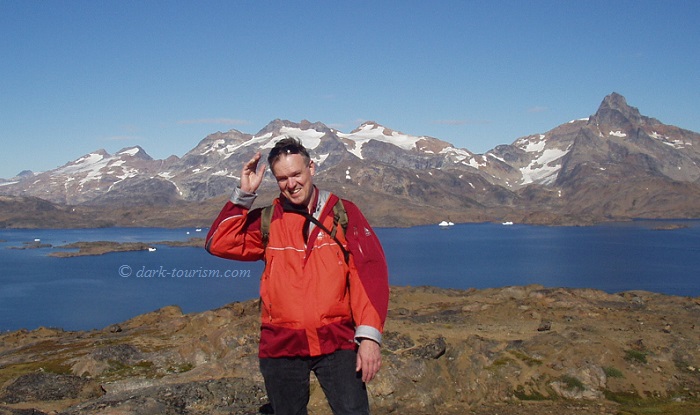
On the website I commented that I picked this image for its profile role precisely because it is not from a dark destination. But I’m having second thoughts about that assessment. I’ve said it often in different contexts that if you only look hard enough and dig deeper you’ll find something dark in practically every country. And that also applies to Greenland, really. All the more so now that Greenland has become one of the focus points for climate change research, as the Greenland icecap is melting at an alarming rate. And this forms its own feedback cycle too, as meltwater also acts as a lubricant, making glaciers move towards the sea faster, thus also accelerating the loss of ice deposited on land, which in turn accelerates the rising ocean levels. If that’s not dark, what is?
But even without such current worries, Greenland also has other aspects that can be seen as dark. To begin with, people also die on Greenland, and hence, like practically everywhere where there are people, there are also burial places (I’m using that word in the widest sense, to cover everything from traditional graves in the ground to cremations in India or even so-called “sky burials” in Tibet). In the photo at the top of the post (repeated below) you can see a few crosses against an Arctic backdrop. This was taken at the cemetery of Kulusuk in East Greenland.

I like the stark contrast between the markers of death and the glorious scenery in the background! Kulusuk, formerly Kap Dan, is only a small settlement of under 300 souls but is of enormous logistic importance, thanks to the airport for East Greenland being located there. This was originally constructed by the US military in the 1950s to serve a radar station that was part of its Distant Early Warning Line set up all over the Arctic region to detect Soviet bombers heading for North America. After the end of the Cold War, this station was dismantled and the airfield became a proper airport for civilian flights.
The main settlement in East Greenland is Tasiilaq, formerly known as Ammassalik or Angmagssalik (many place names in Greenland were changed in the past three decades), and the old name still appears in some places, such as the main hotel and the local museum. Tasiilaq may be the largest settlement in this very isolated part of the world, but it still has only about 2,000 inhabitants! But it is an important base for Inuit hunters to stock up on supplies of fuel and food before they venture out on hunting trips or move to smaller settlements or temporary bases further afield.

There’s only one road in town, and none leading in or out, all land transport outside the town is by snowmobile or dog sled. Kulusuk airport on the island of the same name is some 15 miles (25 km) away and serves as the main entry point for visiting tourists too. These are then transferred to Tasiilaq by helicopter, which also provides a little element of additional adventure.
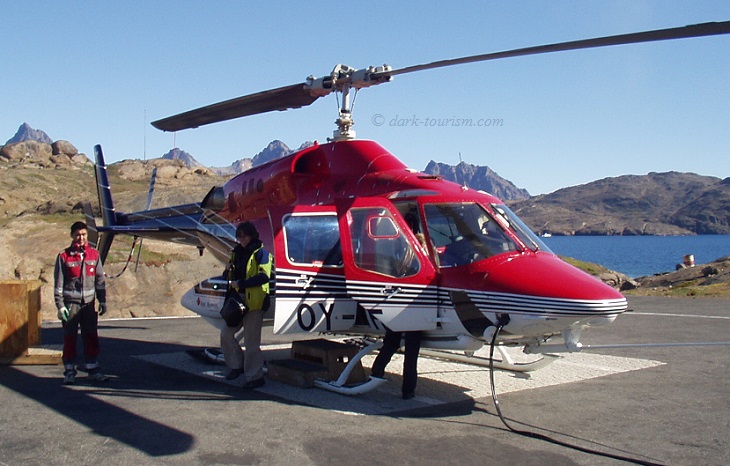
A short trip to East Greenland was a two-day add-on to my trip to Iceland way back in 2004 (hence the above photo of me is a bit flattering … e.g. I no longer have such a full head of hair!). My wife and I flew into Kulusuk on a scheduled Air Iceland flight and from there Air Greenland transferred us to Tasiilaq by this helicopter. On the way back we had a bit of time to kill until the flight back to Iceland departed, so we were able to explore Kulusuk for a bit too, and that’s when the above photo of the cemetery was taken.
Funny anecdote on the side: when we boarded our flight back to Iceland there was only one other plane on the apron at Kulusuk, namely another Air Iceland one, due to fly to a settlement further north. Yet they managed to load all the passengers’ luggage onto that other plane. So after our arrival in Reykjavik, the baggage belt delivered exactly zero pieces, to everybody’s consternation. We were assured that the luggage would be brought in the same day on the late evening flight of that other plane back to Iceland. But it meant that we had to go out in Iceland’s beautiful and fashion-savvy capital in our dirty hiking boots, muddy rain-proof trousers and high-vis rain jackets. In the streets it wasn’t so bad but we also went to a restaurant (for which Icelanders typically dress up). So we felt a bit like uncivilized tramps. After our meal we went back to our hotel, and indeed our luggage had finally arrived, so we were at least able to change into something a bit smarter for going out in the late evening to sample some of Reykjavik’s fabled nightlife scene.
But back to Greenland: in Tasiilaq we went for a hike on the mountain behind the town (and that’s when that photo of me was taken), and in the afternoon we had an iceberg cruise on the fjord that Tasiilaq sits on. Just outside the harbour a huge iceberg was floating in the water that from a distance looked like three separate icebergs, but these segments were all connected below the waterline to a common base. As you know, only a small portion of the ice actually pokes out of the water, below the surface is the much bigger part.
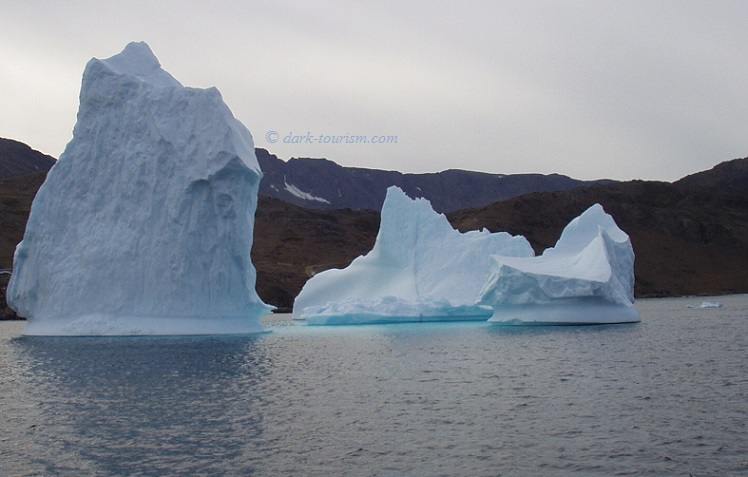
Icebergs can be dangerous too. As they slowly melt they change shape, and every so often this can throw the weight distribution off balance and the whole iceberg suddenly turns in a big splash. You can see evidence of this on the clearly water-shaped surface on parts of icebergs then ending up above water, as in this specimen:
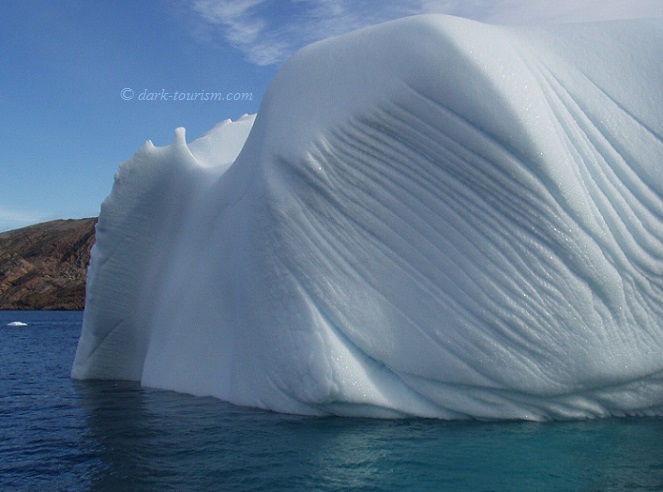
Because icebergs can suddenly turn without warning, you’re normally not supposed to get too close – but our skipper did frequently get quite close and on one occasion up to touching distance. That was in order for him to hack off a block of ice, which he then handed over to our group of six passengers.
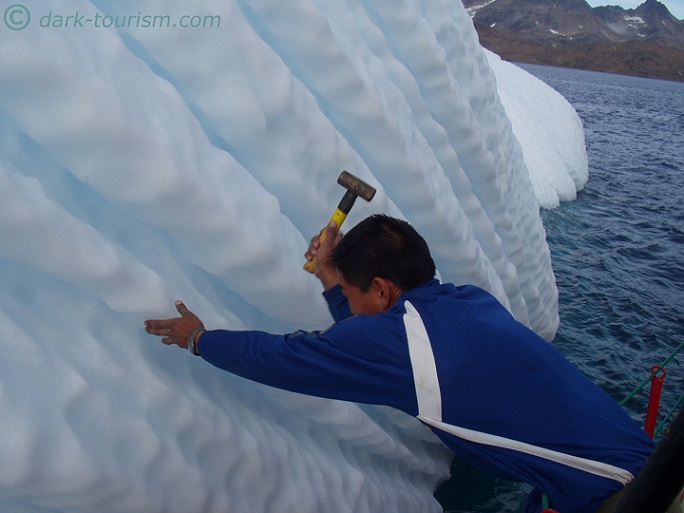
A German guy who was part of our group took a chunk of that ice with him back to the hotel, and later that evening we met him again and he poured me a glass of the Jack Daniel’s whisky he had bought from duty free – with a bit of that iceberg ice in it. Now, normally I would never put ice in whisky (it ruins the aroma and much of the taste), but hey, it was only JD and it was worth it for the sensation of listening to glacial ice thousands of years old crackling in the glass as little air bubbles were being released from their millennia-long imprisonment in the ice.
We had already seen from our hike and the iceberg cruise that a change in the weather was imminent. Mist and thick clouds were rolling in from the open sea. For the next day we had a helicopter excursion to the top of a large local glacier planned, but that had to be cancelled because of the bad visibility. So we had a whole day at hand in Tasiilaq to just wander about. We visited the little local museum, and probably spent much longer there than we would normally have, just to kill as much time as possible. It was quite endearing though.
A visit to the town’s supermarket was also interesting. Where else in the world can you find outboard motors and shelves full of porn videos right next to each other? The freezers were also interesting for their portions of deep-frozen seal meat – another local speciality! In the harbour we even saw freshly killed seals suspended under the waterline off fishing boats by ropes with weights on them. That way they use the cold of the water as a kind of natural fridge before the seal hunter’s booty is cut up.
You could probably say that all this also adds certain dark elements to the destination. Moreover, as we wandered through the cold drizzle, we came to Tasiilaq’s cemetery:
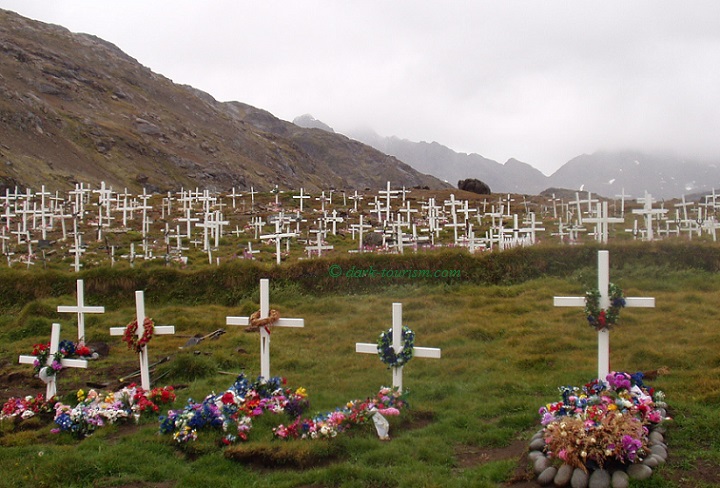
The flowers here are of course not real but plastic. As we often do when we visit a cemetery we read some of the inscriptions. Most were in Inuit, and hence undecipherable to us. Inuit languages are classed in linguistics (in linguistic typology, to be more precise) as “polysynthetic languages”, which means, very roughly speaking, that they are very highly inflecting and have so-called noun incorporation, whereby noun roots are inserted into verb roots. The overall effect is extremely long words that function like full sentences. In fact the difference between word and sentence is thus difficult to make at all. This may have played a role in the origins of the language myth that “Eskimos” (these days ‘Inuit’ is the pc expression, of course) have so many words for snow. In reality Inuit has fewer words for snow than English, but those come in so many forms when used in those whole-sentence-“words” that it may seem like such a wide array of terms, when in fact they are only descriptions. Anyway, the look of written polysynthetic Inuit is quite bizarre to European eyes, and I remember studying the phone book in our hotel room (it was a rainy day, remember!) which was bilingual, Danish and Inuit (well, the local subtype of Inuit, ‘tunumiisut’), so you could compare. This may sound a rather nerdy thing to do, but in my defence I have to point out that at the time I was still a linguistics lecturer (at Nottingham University at that point) so this fell into my subject area’s range of interests, even though I’d never been much of a typology specialist.
Another intriguing linguistic detail I also spotted in the cemetery of Tasiilaq – and with that we’re back on topic. One grave’s tombstone had a plaque with a line in German on it:
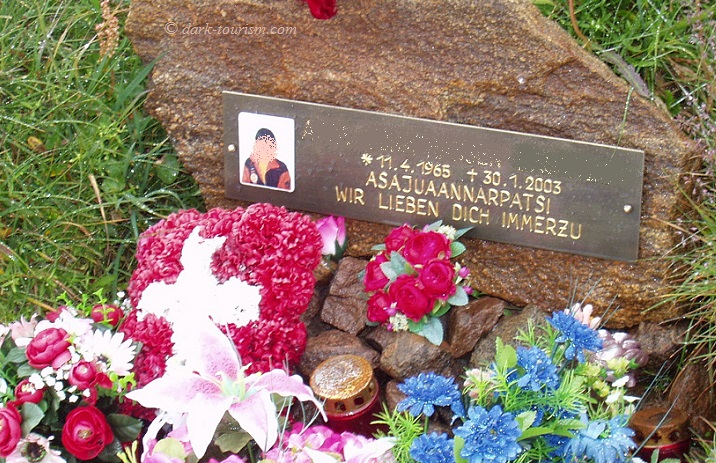
The German line “Wir lieben dich immerzu” would normally translate as ‘we are loving you all the time’ rather than the more conventional ‘we will always love you’, so it almost sounds a bit dodgy. But then I also saw that one wreath of plastic flowers lying in front of the stone was in the colours of the Swiss flag, so maybe it’s a Swiss German expression? I anonymized the tombstone in the above photo but I can report that the person’s name did not suggest any Germanic, or rather Alemannic, connections and looked rather more Danish.
Speaking of Danish, it should perhaps be pointed out that Greenland, the largest island on Earth, is strictly speaking not a fully independent country but nominally part of the Kingdom of Denmark, although the old colonial ties have been loosened in stages to the point that Greenland is now fully self-governed and autonomous and has its own parliament, though it still sends two representatives to the Danish parliament and there’s a Danish high commissioner in Greenland, and the currency is still the Danish Krone.
Back to dark aspects: we were told that Fridays can get a bit dicey in Tasiilaq, as that’s pay day, when some Greenlanders blow a good proportion of their wages on alcohol and get totally trolleyed. Then they become unpredictable and allegedly have on occasions even fired rifles at helicopters or such things. Our second day in Tasiilaq happened to be a Friday, so we were a little apprehensive as we walked into town. But the place felt peaceful enough during the day. To get a break from the constant cold drizzle we even ventured into a bar for locals for a one-off drink. We felt very foreign and very watched by the barman and single other customer. So we quickly left and spent the evening in the cozy safety of our hotel.
Something else to look out for are the dogs. Sled dogs are probably at least as numerous as people in Tasiilaq, but in the summer they spend most of their time chained up in locals’ back yards. We could watch packs of these wolf-like dogs being fed by their owners and every so often the whole town’s dog community would burst into joint howling competitions, which made for a very spooky soundscape. The adult sled dogs are obviously not pets but working dogs, and you should always give them a wide berth as an outsider. However, the puppies and youngsters, who are allowed to roam freely, approached us in the street and sniffed our boots, but they were perfectly harmless …
